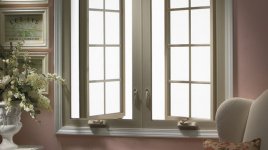Windows come in a number of different frame and glazing types. By combining an energy-efficient frame choice with a glazing type tailored to your climate and application, you can customize each of your home’s windows.
Types of Window Frames
Improving the thermal resistance of the frame can contribute to a window's overall energy efficiency, particularly its U-factor. There are advantages and disadvantages to all types of frame materials, but vinyl, wood, fiberglass, and some composite frame materials provide greater thermal resistance than metal.
Aluminum or Metal Frames
Although very strong, light, and almost maintenance free, metal or aluminum window frames conduct heat very rapidly, which makes metal a very poor insulating material. To reduce heat flow and the U-factor, metal frames should have a thermal break - an insulating plastic strip placed between the inside and outside of the frame and sash.
Composite Frames
Composite window frames consist of composite wood products, such as particleboard and laminated strand lumber. These composites are very stable, they have the same or better structural and thermal properties as conventional wood, and they have better moisture and decay resistance.
Fiberglass Frames
Fiberglass window frames are dimensionally stable and have air cavities that can be filled with insulation, giving them superior thermal performance compared to wood or uninsulated vinyl.
Vinyl Frames
Vinyl window frames are usually made of polyvinyl chloride (PVC) with ultraviolet light (UV) stabilizers to keep sunlight from breaking down the material. Vinyl window frames do not require painting and have good moisture resistance. The hollow cavities of vinyl frames can be filled with insulation, which makes them thermally superior to standard vinyl and wood frames.
Wood Frames
Wood window frames insulate relatively well, but they also expand and contract in response to weather conditions. Wood frames also require regular maintenance, although aluminum or vinyl cladding reduces maintenance requirements.
Types of Window Glazing or Glass
In addition to choosing a frame type, you will need to consider what type of glazing or glass you should use to improve your home's energy efficiency. Based on various window design factors such as window orientation, climate, building design, etc., you may even want to choose different types of glazing for different windows throughout your home.
Gas Fills
To improve the thermal performance of windows with insulated glazing, some manufacturers fill the space between the panes with inert gas - commonly argon or krypton - that has a higher resistance to heat flow than air.
Heat-Absorbing Tints
Heat-absorbing window glazing contains special tints that change the color of the glass. Tinted glass absorbs a large fraction of the incoming solar radiation through a window, reducing the solar heat gain coefficient (SHGC), visible transmittance (VT), and glare.
Some heat, however, continues to pass through tinted windows by conduction and re-radiation, so the tint doesn't lower a window's U-factor. Inner layers of clear glass or spectrally selective coatings can be applied on insulated glazing to help reduce these types of heat transfer.














